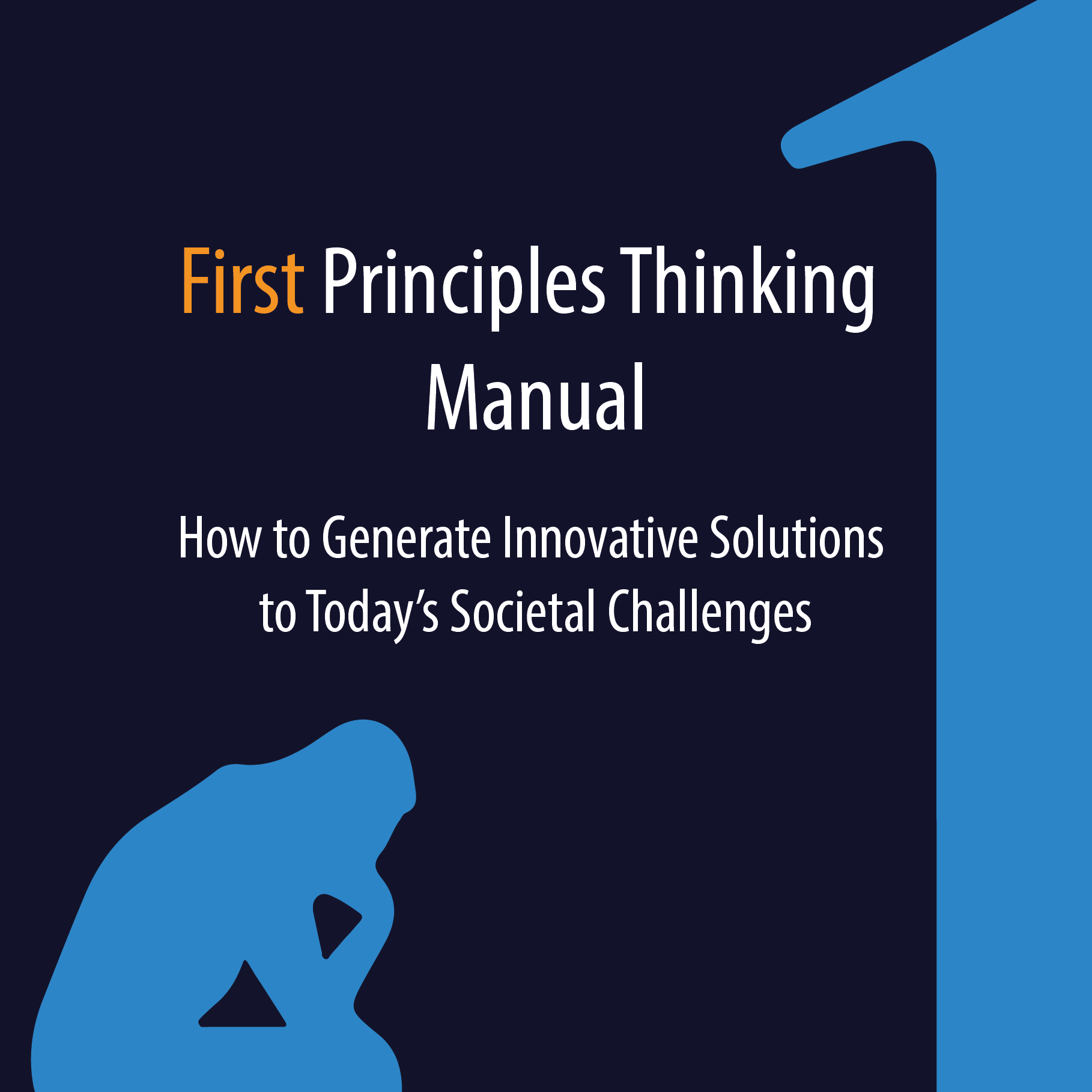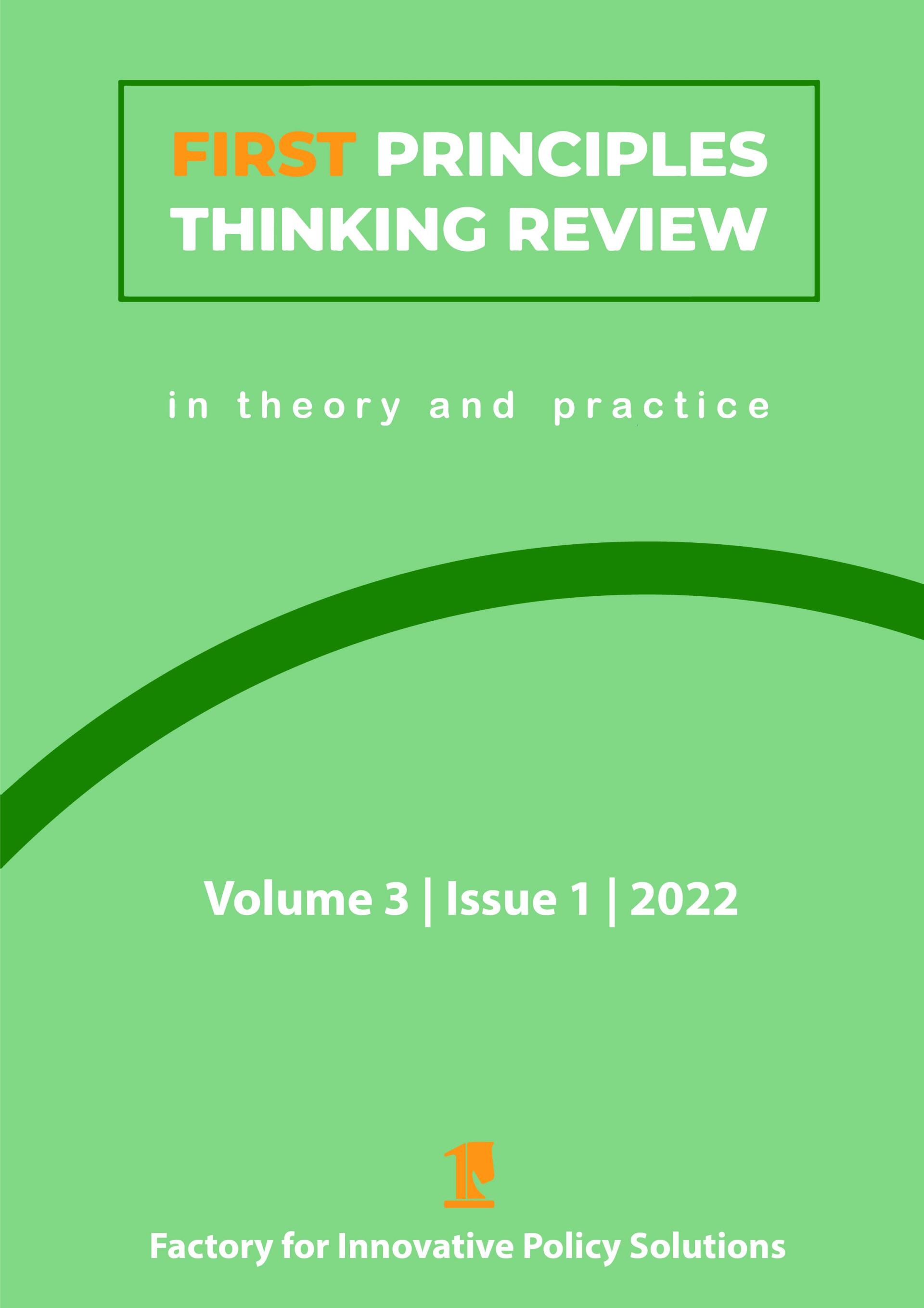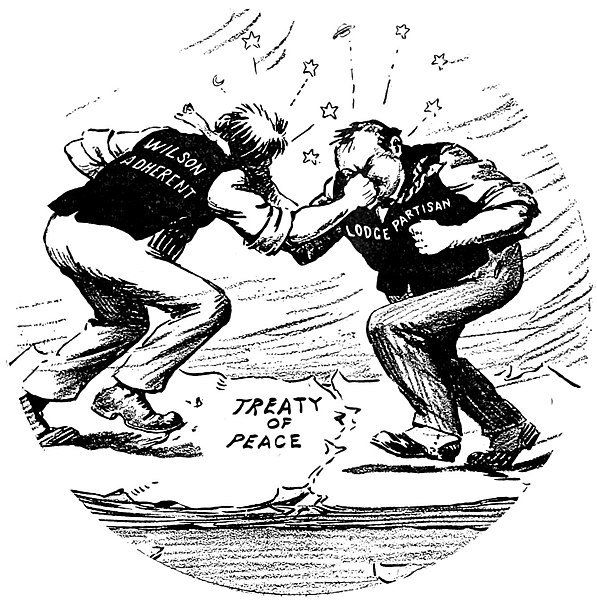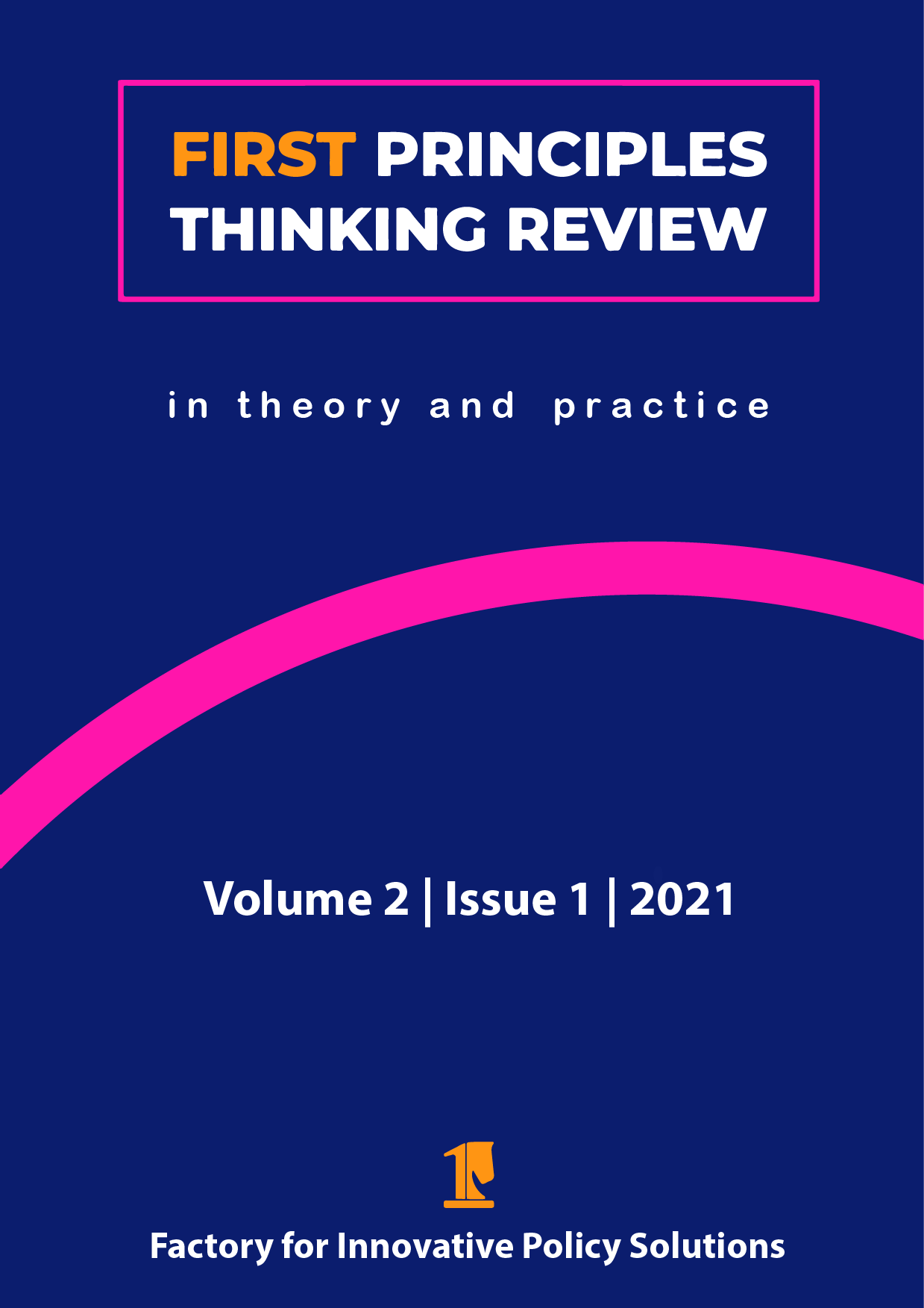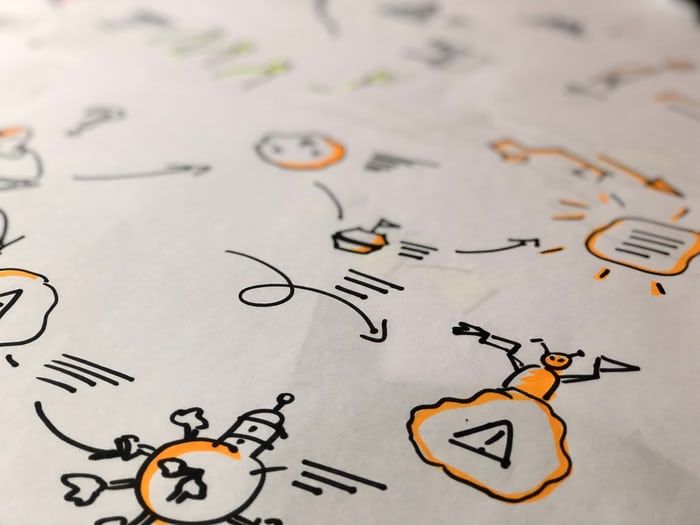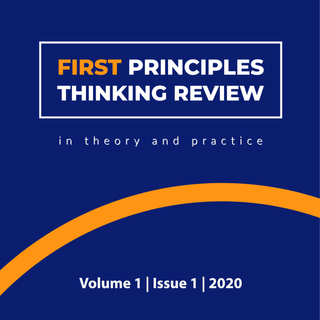First Principles Thinking as a Tool for Decision-Making
First principles thinking can be used for several purposes, ranging from coming up with innovative solutions, to deepening your understanding about a topic and contextualising your research. The potential of this technique is far reaching but several of its applications are underexposed. This article provides you with practical insights on another way in which the technique can be helpful: making decisions.
First principles thinking and decision-making
According to Lumen Learning (n.d.), decision-making refers to making choices among alternative courses of action. But what if you’re unhappy with the alternatives in front of you? To identify new alternatives or improve your current options you might want to approach the situation like a problem-solver, and a first principles thinker in particular.
You make about 35,000 decisions a day (Psychology Today, 2018): What radio channel do I listen to? And on what volume precisely? Will I give this Instagram photo a like? What about the next photo? Will I continue reading this article? Understandably, most decisions are taken on automatic pilot. But what if certain decisions are suboptimal or costly in the long-term?
In the following circumstances it might be worthwhile to embrace the guidance of first principles thinking:
- When you make habitual decisions that are harmful or costly, for example pouring ketchup over your meals.
- When you’re confronted to make a decision that others have not yet been confronted with, for example deciding on how to deal with an extraterrestrial invasion in your backyard.
- When you’re confronted to make a decision that others have not yet made in a way that resulted in optimal success, for example how to contain the spread of an infectious disease at its source without frustrating the local economy.
- When you’re dissatisfied with the quality and quantity of the decision options that are currently apparent to you, for example deciding on what profession to pursue when living in a small secluded village.
- When you want to decide on how to best solve a concrete problem or achieve a concrete goal, especially those that others have failed at, for example diverting a tornado from its natural course.
If I were to make a decision based on first principles, this is what I would do: identify the problem that the decision aims to solve, break down what I think I know about the problem into basic scientific truths and reason up from there to discover new, hopefully more yielding, avenues. This way, first principles thinking would help get to the root of the issue we’re deciding on to discover approaches and decisions that we are unaware of at first.
Example: which car should I buy?
Below you find some steps that may help guide your decision-making process. The workings of first principles thinking are illustrated in the context of a decision that my friend was pondering: “Which car should I buy to commute from my new home in rural Sweden to my workplace in town?” Being a first principles thinker, I asked him why he feels that he needs a car. “Because my partner uses the one car we have to go to work in the opposite direction and leaves at a much earlier time”. “Why does that make you need another car?” He got hesitant to answer, and so our first principles thinking exercise began.
Step 1: Identify the problem and turn it into an objective
A rational decision-maker would probably compare different cars in terms of price, safety, looks, horsepower, etc. and make a decision based on what aspects he or she values most in a car.
While this approach can be useful when you have deliberately decided that buying a car is what you want, you can also take a step back and ask yourself what problem the decision would solve in the first place. Buying a car could, for example, solve the problem of not being able to travel in between home and work.
If you find that there is no problem or objective, it might not matter too much what decision you opt for or you might not even need to make a decision at all. If you did identify a problem, the first principles thinking method dictates you to transform it into an objective statement that concretely addresses what needs to be improved, for whom and in which locality, without demarcating it further than this. The objective for my friend would, for example, be:
- Become able to get to work and back home on workdays.
Step 2: List your obstacles
As with any goal, there are always obstacles in the way. To identify them, ask yourself: What hinders this objective from not being achieved (yet), or what are the causes? I found it helpful to focus on the most important ones:
- My work requires physical presence.
- My work in the city is far away from my home.
- There is no public transportation between my house and work.
Step 3: Question your assumptions
As with any first principles thinking exercise, you need to temporarily embrace that everything you think you know about each obstacle may be untrue. Asking ‘Socratic questions’ can help challenge these previously held beliefs:
- Does my work truly require physical presence? Is work actually far from home? Is there really no public transportation? Why do I think that? What is the evidence?
Once you have let go of your assumptions we can move on to identifying first principles.
Step 4: Uncover some first principles
To get to the first basis from which a thing is known —the very first principles— you could ask fundamental questions that break down the obstacles:
First obstacle: My work requires physical presence
- What concrete activities at work require my presence? How much time do these activities take? What is the yield of doing these activities? Are the activities worth buying a car for? Am I the only one who can perform these activities?
Second obstacle: My work is far away from my home
- How far is work exactly, by road and by sky? How long does it take to get there by various means of transportation?
Third obstacle: There is no public transportation
- What criteria need to be fulfilled for public transportation to be a viable option for the municipality and transport provider? What vehicles pass my house/neighbourhood, and how often? What criteria need to be fulfilled to get to work within 30 minutes? What existing vehicles fulfill these criteria? What do they cost? Do neighbours and coworkers also experience inconvenience from the absence of transportation?
If you have not done so already, try to answer and deduce as many questions as possible. In doing so, try to stick to facts as much as possible. An educated guess or a search engine query will most of the time do just fine at this stage.
First obstacle: My work requires physical presence
- Internal meetings, which take about 10% of my time at work, require physical presence. Few of my interventions during these meetings are spontaneous. Although my input is well received, I am not convinced it is worth the costs of a car. Colleagues could be trained to do the activities requiring physical presence.
Second obstacle: My work is far away from my home
- Work is located about 17 kilometres (10 miles) away by road and 12 kilometres (7.5 miles) by radius. To get there it takes about 17 minutes by car, 1 hour by bike and 3.5 hours on foot.
Third obstacle: There is no public transportation
- The Swedish association for local governments gives some indicative answers: the minimal bus occupancy rate lies around 5 persons per vehicle, the minimal number of bus rides per inhabitant per year is 25 and the maximum costs per kilometre should not exceed 33 Swedish Crowns (€/$3.50) (Sverige Kommuner och Landsting, 2016.
- About 25 close neighbours and 8 coworkers also experience inconvenience as a result of a lack of transportation.
- In between 07-08h on weekdays, about 12 cars, 3 agricultural vehicles and 1 motorcycle pass my house. The transportation modality needs to be able to carry about 90 kilos (200 pounds); speed up to at least 40km/h (25 miles/h); be allowed on the road or in the sky; withstand rain, snow and wind; and be cheaper than a car.
- These vehicles more or less fulfil the criteria: electric bike (€/$1,500) (Bikester, n.d.), moped (€/$1,500) (Köpenscooter Omdömen, n.d.), paramotor (€/$2,000) (Wikipedia, n.d.; Ebay, n.d.). Off road scooters like golf carts and quad bikes are not allowed on a regular public road (Transportstyrelsen, n.d.).
This foundational and semi-factual information consists of first principles.
Step 5: Come up with new ideas
To turn the first principles into innovative ideas, you could ask how-questions that link the first principles with the selected obstacles and try to answer them:
First obstacle: My work requires physical presence
- How can we decrease the % of internal meetings I attend? Compress meetings to one day; swap meeting-intensive tasks with colleagues.
- How can I contribute to meetings without being physically present? Email the input beforehand; ask a colleague to provide input on your behalf; join via video or telephone.
Second obstacle: My work is far away from my home
- How can we decrease the distance? Create a shortcut; travel by air; flatten the road; make the road more bike-friendly; sleep at work during weekdays; open a satellite office closer to home; move closer to work; get a mobile home; start a new business from home.
- How can we decrease the time it takes by modalities that are currently too slow? Put a motor on a bike or buy an electric bike; increase your physical endurance so that you can bike faster.
Third obstacle: There is no public transportation
- How can we achieve a bus occupancy rate of 5 persons per bus? How can we achieve that residents take at least 25 bus rides per year? How can we make public transportation cheaper for the user than currently used modes of transportation? How can we ensure that the maximum costs per driven kilometre will not exceed 33 Swedish Crowns? First launch a questionnaire to see how many neighbours would use public transportation, how often and for which price?
- How can we increase the population density of the village so that public transportation becomes a necessary or viable service? Attract real estate developers to build a residential flat or hospital.
- How can we find out where the vehicles passing my house are going? How can we convince those going to the city to give me a lift? Try hitchhiking with a banner saying something like “FREE COFFEE in return for a ride to town” and try to make more permanent arrangements.
- How can we build a vehicle that fulfills the criteria? Unsure.
- How can we get an e-bike or paramotor? Simply order it online or make one yourself.
- How can we legalise certain vehicles? Instal an additional strip of land for golfing/quadding next to the road where golf carts and quad bikes would be allowed.
- How can we team-up with neighbours or coworkers that also struggle to get to the city? Write a letter to the municipality; buy one vehicle together for ‘vehicle pooling’; ask the company to provide a shuttle service for employees.
As you may have noticed, we only answered the questions that we could relatively easily find an answer or idea to.
What to do with all these possible decisions?
Now that you have multiple ideas you could do three things:
First , refine them, for example by setting the realisation of these ideas as your subgoal and, again, applying first principles thinking to come up with refined ideas to achieve it. For example:
- Step 1: The goal is to make the company provide a shuttle service for employees.
- Step 2: The main obstacle seems that this would cost the company money.
- Step 3: The assumption to question here could be whether it really is costly; let’s suppose it doesn’t need to.
- Step 4: The fundamental questions could then be: What are the cost components exactly? How much would this cost for each employee? A simple calculation (footnote 1) leads to the following first principle: It costs about 375 Crowns (€/$35) per employee per month for this system to operate.
- Step 5: We could then ask: How can we make it beneficial for the employer to cover these costs? One idea that pops up is for the car to arrive at work a few minutes early and leave a few minutes late everyday. The additional minutes could be used by the employees to work overtime and compensate for the employer’s expenses. Each employee would need to work about 4.5 additional minutes every workday to make this work (footnote 2) . Now you have a concrete proposal.
Second , assess the potential of each idea against evaluation criteria that you or your surroundings find important, for example local laws, political reality, risks and feasibility. Whenever you’re about to drop an idea, for example because it appears to entail too many risks, you could first make it your goal to reduce these risks, and apply first principles thinking to do so.
- Knowing that the employer values sustainability, she would probably not agree to pay for lease cars that run on ordinary petrol. After a quick first principles thinking exercise, a logical solution seems to be that they need to be electric cars and that employees would need to arrive about 10 minutes early and leave 10 minutes late to compensate for the costs of this pricier variant.
Third , when you have a few promising solutions, you could start implementing those solutions that seem most cost-effective, or individually necessary and/or jointly sufficient to achieve your objective.
- The refined solution of carpooling seems to be quite cost-effective for my friend to commute to work. He could then decide to propose it to the employer.
For further guidance on refining and selecting your ideas, you could check out steps 6 and 7 of the First Principles Thinking Manual.
Conclusion
Indeed, instead of buying a Volvo V90, my friend will first try to realise some of the ideas presented above. Although most ideas are not extremely innovative, some of them are unlikely to be thought of without applying first principles thinking.
The far reaching potential of this method for innovative and realistic decision-making is attributable to the fact that it combines aspects of both creative and rational decision-making, at the very core of the issue in question.
As the example illustrates, the application of first principles thinking to a relatively simple decision with a straightforward underlying goal can become quite comprehensive. While this can make for a hefty mental challenge, it also provides for ample ingredients from which solutions can be generated; so use them!
You’ll see: the more often you apply first principles thinking to decision-making and problem-solving, the more intuitive the process gets, sometimes getting to great ideas even before you start to actively question your assumptions.
Footnotes
- The cost components are about 2,500 Swedish Crowns (€/$250) per month for the lease and 500 Crowns for gasoline of two second hand five-seater cars, if the most efficient routes are taken. How much would it cost per person per month? A total of 2,500 plus 500 Crowns divided by 8 coworkers is 375 Crowns.
- How many minutes do employees need to work per month to earn this? 375 Crowns divided by an average gross hourly salary of 260 Crowns is about 1.5 hours, or 90 minutes. 90 minutes divided by 20 workdays per month is 4.5 minutes.
References
- Bikester. (n.d.). Elcycklar. https://www.bikester.se/cyklar/elcyklar/?srule=price-low-to-high&page=1&sz=48
- Ebay. (n.d.). Paramotor. https://www.ebay.com/sch/i.html?_from=R40&_trksid=m570.l1313&_nkw=paramotor&_sacat=0
- Lumen Learning. (n.d.). Understanding Decision Making. https://courses.lumenlearning.com/principlesmanagement/chapter/11-2-understanding-decision-making/
- Köpenscooter Omdömen. (n.d.). Hemsidan. https://www.kopenscooter.nu/sv/
- Eva Krockow (2018) How Many Decisions Do We Make Each Day? Psychology Today. https://www.psychologytoday.com/intl/blog/stretching-theory/201809/how-many-decisions-do-we-make-each-day
- Sverige Kommuner och Landsting. (2016) Öppna jämförelser kollektivtrafik 2016. https://www.skane.se/Public/Protokoll/Regionala%20utvecklingsn%C3%A4mnden/2017-02-03/Verksamhetsinformation%20-%20regionala%20utvecklingsn%C3%A4mnden%202017-02-03/%C3%96ppna%20j%C3%A4mf%C3%B6relser%20kollektivtrafik%202016.pdf
- Transportstyrelsen. (n.d.). Terrängmotorfordon. https://transportstyrelsen.se/sv/vagtrafik/Fordon/Fordonsregler/Terrangmotorfordon1/
- Wikipedia. (n.d.). Paramotor. https://sv.wikipedia.org/wiki/Paramotor#:~:text=En%20paramotor%20%C3%A4r%20en%20motor,%C3%A5r%20(g%C3%A4ller%20endast%20SSFF).
Apply first principles thinking yourself?
Would you like to apply first principles thinking yourself and have your problem-solving experience published in the First Principles Thinking Review? Then be sure to check out the submission guidelines and send us your rough idea or topic proposal. Our editorial team would be happy to work with you to turn that idea into an article.
Share this page
Disclaimer : The views, thoughts and opinions expressed in submissions published by FIPS reflect those of the authors and do not necessarily reflect the views held by FIPS, the FIPS team or the authors' employer.
Copyrights : You are more than welcome to share this article. If you want to use this material, for example when writing an article of your own, keep in mind that we use cc license BY-NC-SA. Learn more about the cc license here .
What's new?
